Have you ever wondered about the tiny, active fish that tirelessly work to keep your aquarium clean? Meet the Otocinclus, a small catfish species that has captured the hearts of aquarists worldwide. These charming bottom-dwellers belong to the Loricariidae family, which also includes the well-known Plecostomus.
Table of Contents
Otocinclus, often referred to as “Otos” in the aquarium trade, are native to the tropical waters of South America. They can be found in various river systems, including the Amazon, where they thrive in well-oxygenated, fast-flowing streams with plenty of vegetation.
One of the most interesting facts about Otocinclus is their diet. These little algae-eaters are known for their voracious appetite, constantly grazing on the algae that grows on plants, décor, and even the tank walls. Their unique mouth structure, featuring a sucker-like disc, allows them to efficiently scrape off algae from various surfaces.
Otocinclus are generally peaceful and social fish, making them excellent tank mates for other non-aggressive species. They prefer to be kept in groups of at least six individuals, as they find comfort and security in numbers. When kept in a well-maintained aquarium with compatible tank mates, Otos can live up to 5 years or more.
Did you know that there are over 20 recognized species of Otocinclus? Some of the most popular ones in the aquarium trade include O. affinis, O. macrospilus, and O. vittatus. Despite their diversity, all Otocinclus species share similar care requirements and endearing personalities.
When setting up a tank for Otocinclus, it’s essential to provide them with a well-established aquarium with plenty of hiding spots and vegetation. These fish appreciate a strong water flow and excellent filtration to mimic their natural habitat. A temperature range of 72-82°F (22-28°C) and a pH between 6.0 and 7.5 are ideal for their well-being.
Fun fact: Did you know that Otocinclus are not only algae-eaters but also skilled acrobats? They are often seen clinging to plants or décor upside-down, showcasing their impressive agility and balance.
In addition to their algae-eating prowess, Otocinclus also play a crucial role in maintaining a healthy aquarium ecosystem. By consuming excess algae, they help prevent algal overgrowth and keep the tank looking pristine. However, it’s important to note that Otos should not be solely relied upon for algae control, as they require supplementary feeding with high-quality algae wafers or blanched vegetables.
The history of Otocinclus in the aquarium hobby dates back to the early 20th century when they were first introduced to the trade. Since then, these endearing catfish have gained popularity among aquarists for their algae-eating abilities, peaceful temperament, and adorable appearance.
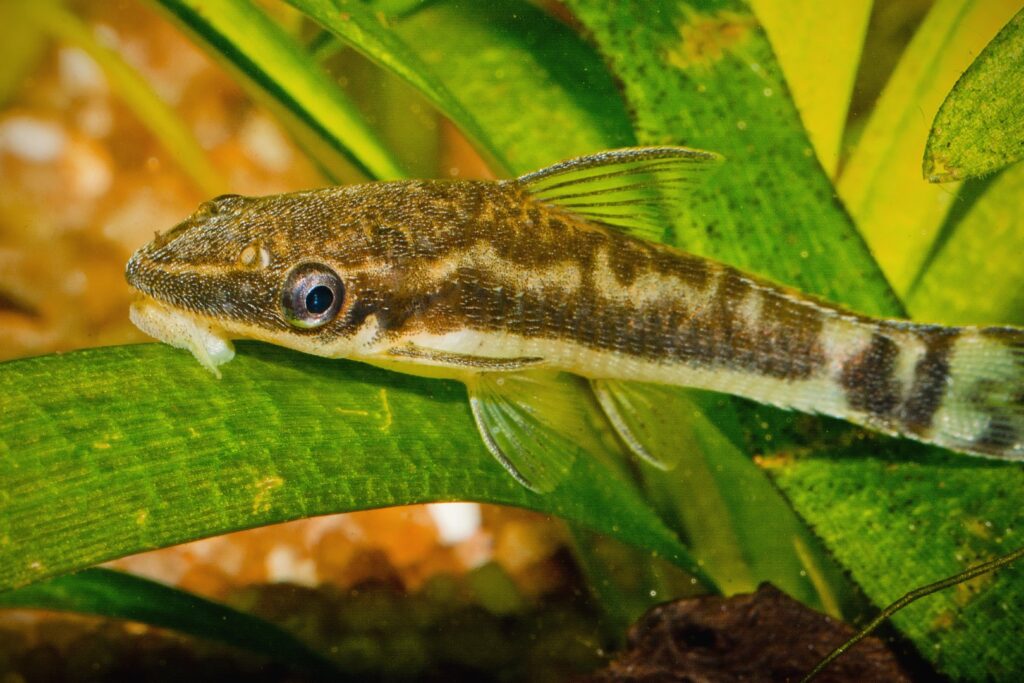
Key Information
Otocinclus, the tiny algae-eating catfish, are known for their subtle yet captivating appearance. These small fish typically feature a light brown or grayish body adorned with darker vertical stripes or spots, depending on the species. Some varieties, such as the Zebra Otocinclus (Otocinclus cocama), showcase more prominent black and white striped patterns, adding a striking contrast to their delicate frame. The understated coloration of Otocinclus allows them to blend seamlessly into their environment, making them a natural fit in most aquariums.
| Characteristic | Description |
|---|---|
| Family | Loricariidae |
| Common Names | Otocinclus, Oto, Dwarf Suckermouth Catfish |
| Origin | South America (Brazil, Colombia, Peru, Venezuela) |
| Price | $2 to $5 per fish |
| Variants | O. affinis, O. macrospilus, O. vittatus, O. cocama (Zebra Otocinclus) |
| Ideal Tank Size | Minimum 10 gallons, 20+ gallons preferred |
| Water Parameters | Temperature: 72-82°F (22-28°C), pH: 6.0-7.5, Hardness: 5-15 dGH |
| Lifespan | 3 to 5 years |
| Full Size | 1 to 2 inches (2.5 to 5 cm) |
| Natural Environment | Fast-flowing, well-oxygenated streams and rivers with abundant vegetation |
| Behavior | Peaceful, social, active, constantly grazing on algae |
| Habitat Preference | Bottom to mid-level dweller, enjoys clinging to plants and décor |
| Aquarium Decoration | Plenty of live plants, driftwood, rocks, and hiding spots |
| Ideal Tank Mates | Small, peaceful fish such as Tetras, Rasboras, Corydoras, and shrimp |
| Fish to Avoid | Large, aggressive, or boisterous fish that may outcompete or frighten Otocinclus |
| Best Foods/Diet | Primarily algae, supplement with high-quality algae wafers and blanched vegetables |
| Disease | Susceptible to common aquarium diseases if water quality is poor or stress levels are high |
| Sex-Switch | No sex-switching behavior |
| Gender Differences | Difficult to distinguish, females may be slightly larger and rounder when mature |
| Care Level | Easy to moderate, requires a well-established and maintained aquarium |
| Breeding Level | Difficult, rarely bred in captivity due to specific water parameters and food requirements |
Ideal Tank Mates
When considering ideal tank mates for Otocinclus, it’s essential to choose fish that share similar water parameters, temperament, and habitat preferences. Otocinclus are peaceful, non-aggressive fish that thrive in the company of other calm and friendly species. They prefer well-established aquariums with plenty of vegetation and hiding spots, as well as good water quality and filtration.
Compatible tank mates for Otocinclus should not be overly boisterous or aggressive, as this can cause stress and hinder the Otos’ natural behavior. Ideal tank mates are those that occupy different levels of the aquarium, reducing competition for space and resources. Additionally, it’s crucial to avoid fish that are known to be fin-nippers or may mistake the Otocinclus for a tasty snack.
Here are 15 ideal tank mates for Otocinclus, along with explanations of why they make suitable companions:
Neon Tetras (Paracheirodon innesi)
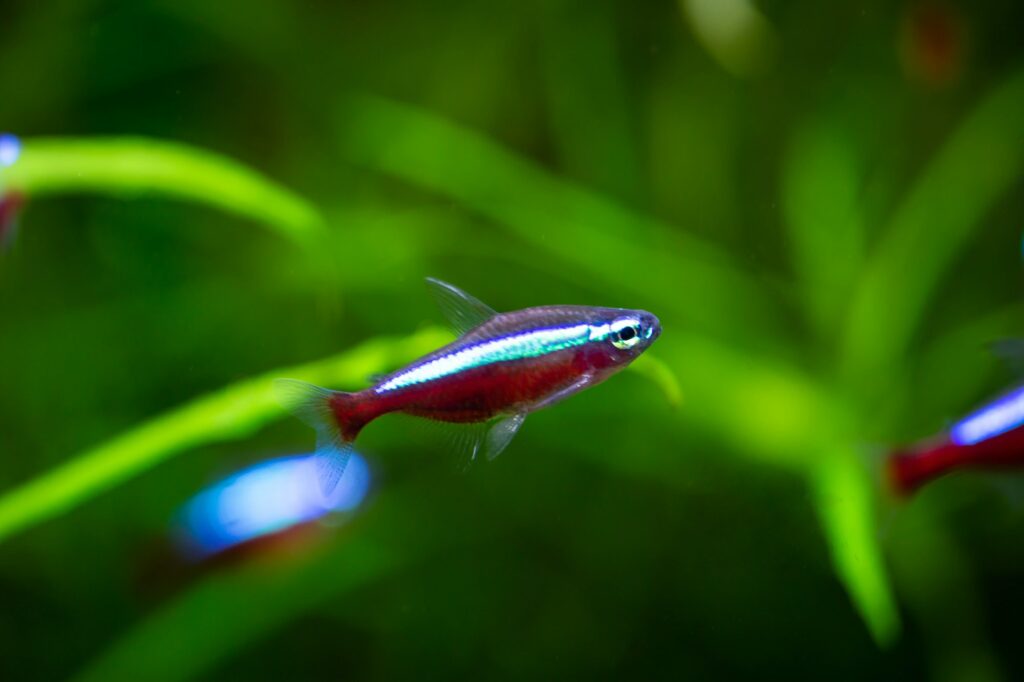
Neon Tetras are small, peaceful, and colorful fish that occupy the mid-level of the aquarium. Their gentle nature and similar water requirements make them excellent companions for Otocinclus. The vibrant colors of Neon Tetras can also provide a stunning visual contrast to the subtle hues of Otos.
Harlequin Rasboras (Trigonostigma heteromorpha)

Harlequin Rasboras are another small, schooling fish that coexist well with Otocinclus. These active swimmers prefer the upper levels of the aquarium, leaving plenty of space for Otos to graze on algae in the lower regions. Harlequin Rasboras are known for their peaceful temperament and adaptability to various water conditions.
Cherry Barbs (Puntius titteya)
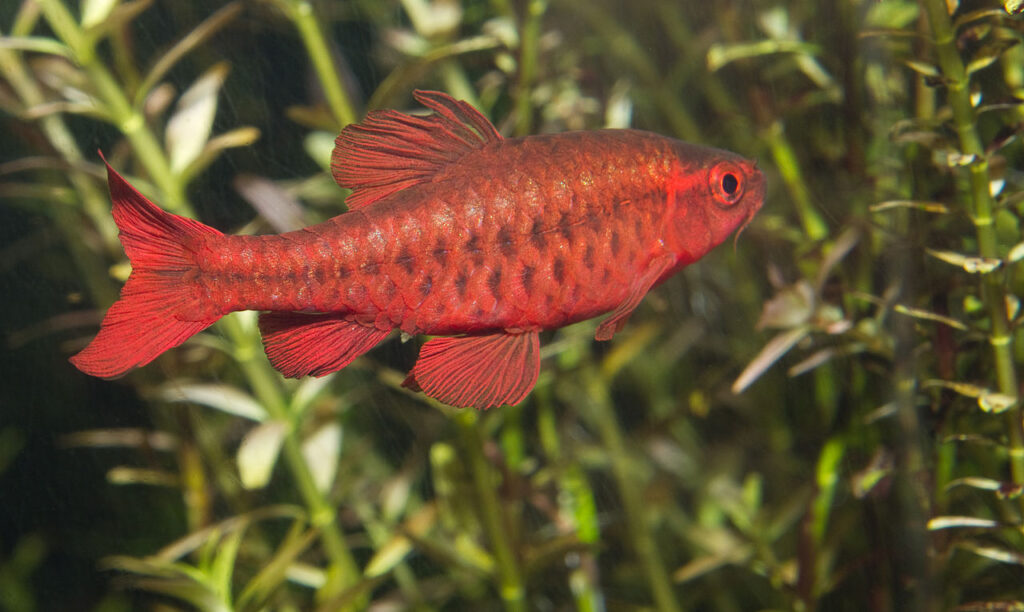
Cherry Barbs are small, attractive fish that add a pop of color to the aquarium. Their peaceful nature and preference for the mid-to-upper levels of the tank make them suitable tank mates for Otocinclus. Cherry Barbs are active swimmers that will not disturb the Otos as they go about their algae-eating duties.
Corydoras Catfish (Corydoras spp.)
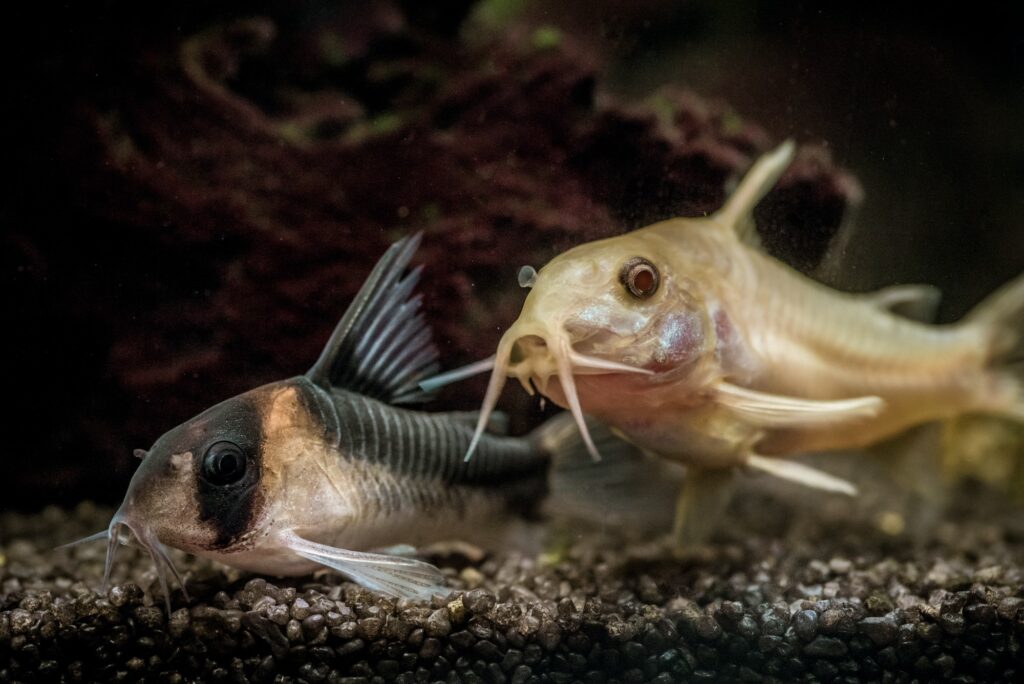
Corydoras Catfish, like Otocinclus, are peaceful bottom-dwellers that help keep the substrate clean. These social fish are best kept in groups and share similar water requirements with Otos. Corydoras and Otocinclus can often be seen foraging together, creating a charming display of catfish camaraderie.
Kuhli Loaches (Pangio kuhlii)
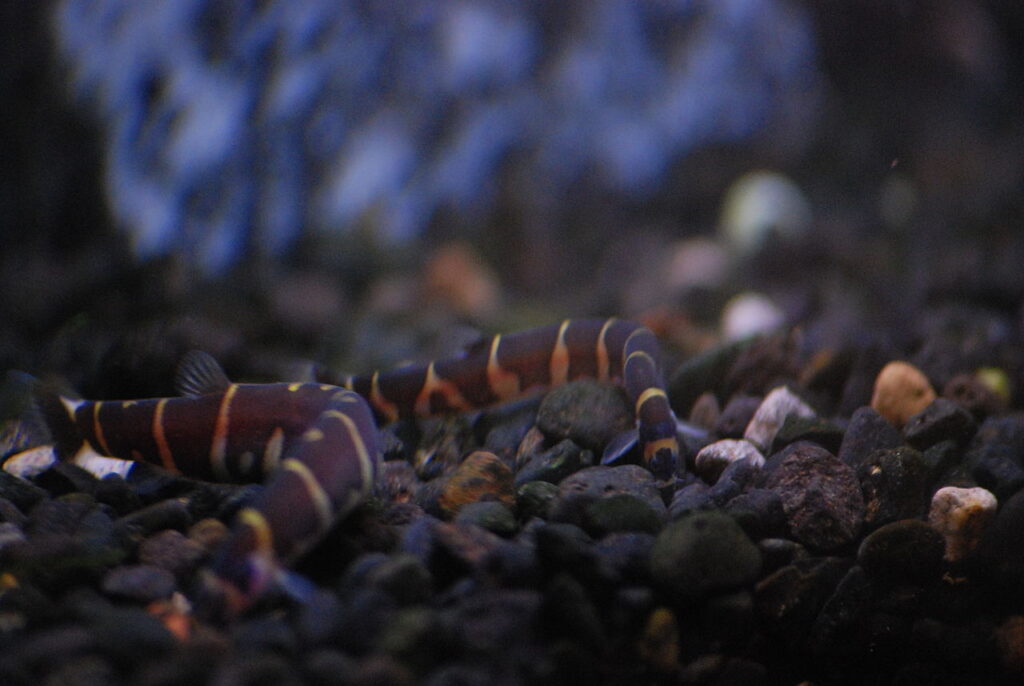
Kuhli Loaches are nocturnal, eel-like fish that inhabit the lower levels of the aquarium. Their peaceful nature and unique appearance make them fascinating additions to an Otocinclus tank. Kuhli Loaches are skilled scavengers that help maintain a clean and healthy substrate without disturbing the Otos.
Ember Tetras (Hyphessobrycon amandae)
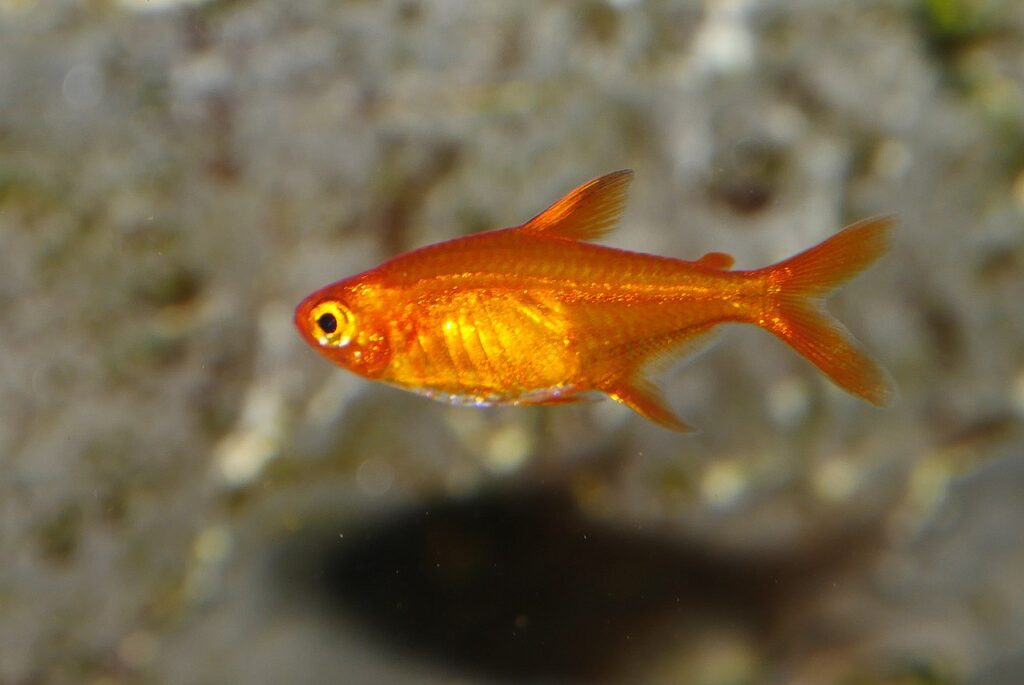
Ember Tetras are tiny, fiery-colored fish that add a vibrant splash of color to the aquarium. These peaceful schooling fish occupy the mid-level of the tank and are known for their lively, yet non-aggressive behavior. Ember Tetras are a perfect match for Otocinclus, as they share similar water preferences and won’t outcompete the Otos for food or space.
Endler’s Livebearers (Poecilia wingei)
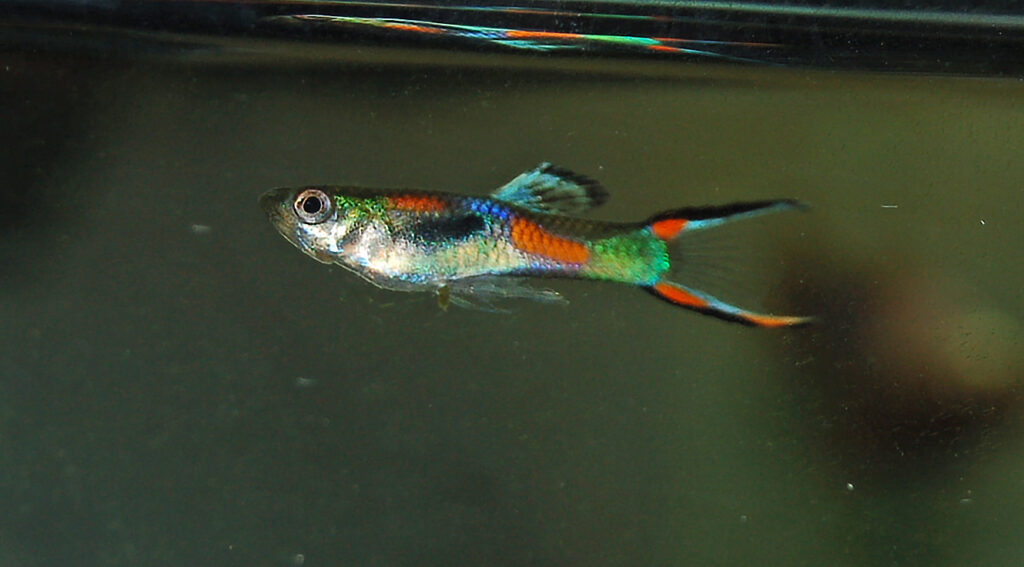
Endler’s Livebearers are small, colorful fish that bring life and movement to the upper levels of the aquarium. These peaceful fish are well-suited for community tanks and won’t bother the Otocinclus as they graze on algae. Endler’s Livebearers are hardy fish that adapt well to a variety of water conditions, making them ideal tank mates for Otos.
Pygmy Corydoras (Corydoras pygmaeus)
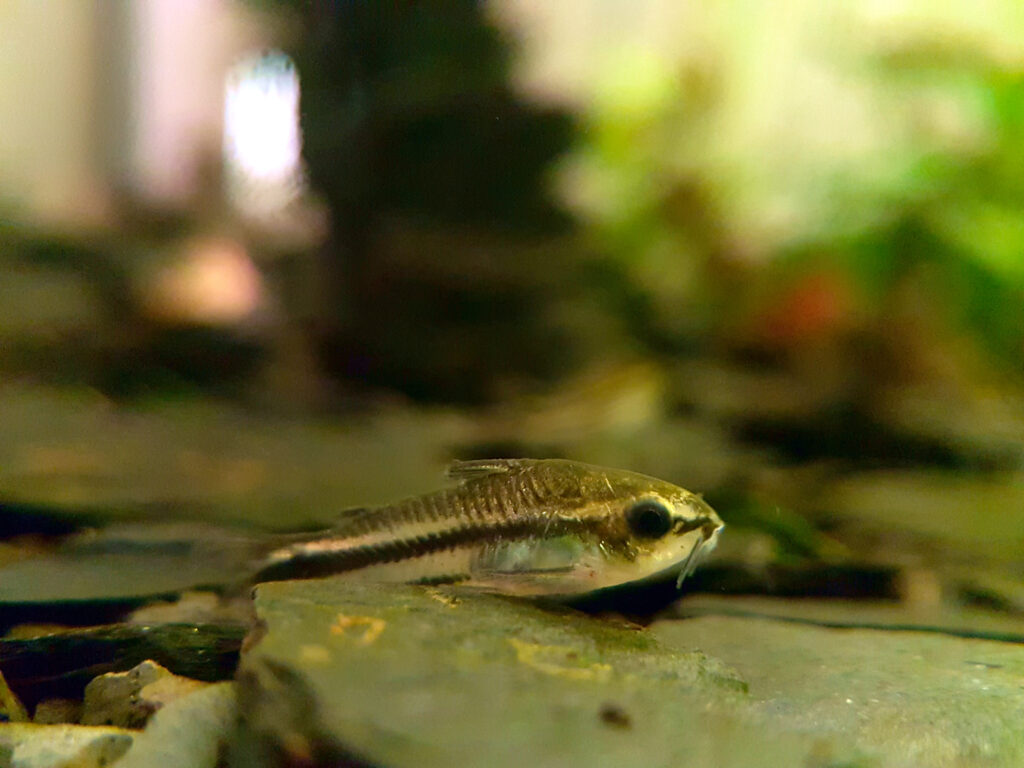
Pygmy Corydoras are miniature versions of their larger Corydoras cousins. These tiny bottom-dwellers are peaceful, social fish that enjoy the company of their own kind and other non-aggressive species. Pygmy Corydoras and Otocinclus make an adorable and complementary pair, working together to keep the lower regions of the tank clean and well-maintained.
Lambchop Rasboras (Trigonostigma espei)
Lambchop Rasboras, also known as False Harlequin Rasboras, are small, peaceful fish that add a touch of elegance to the aquarium. These schooling fish occupy the mid-to-upper levels of the tank and are known for their gentle demeanor. Lambchop Rasboras and Otocinclus make a visually stunning and harmonious combination, with the Rasboras’ graceful movements complementing the Otos’ diligent algae-eating habits.
Celestial Pearl Danios (Danio margaritatus)
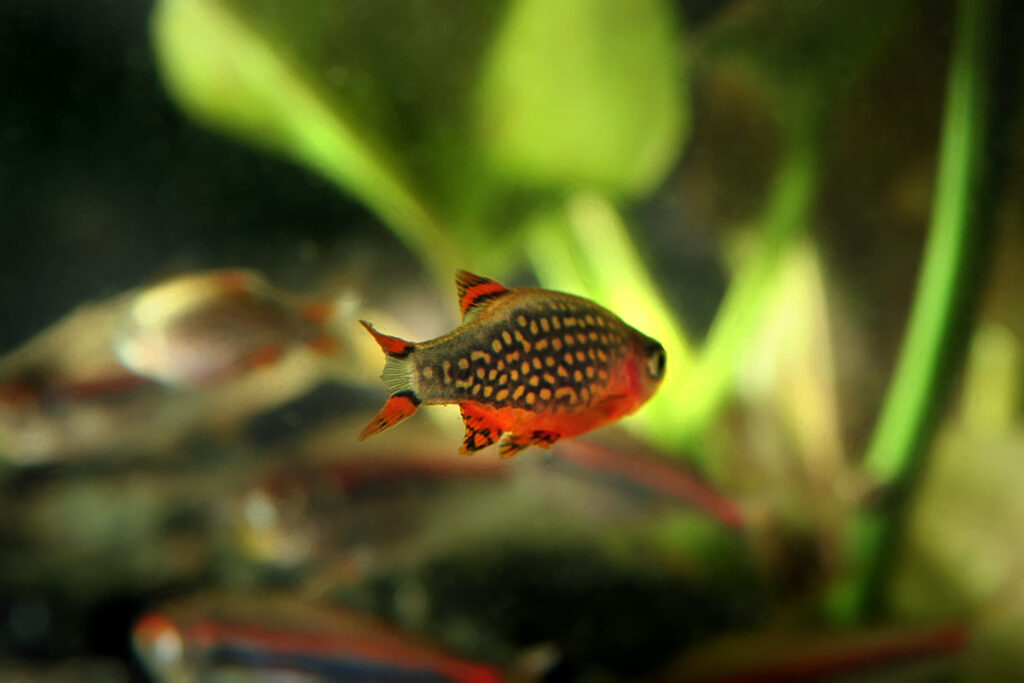
Celestial Pearl Danios, also known as Galaxy Rasboras, are small, strikingly patterned fish that bring a touch of celestial beauty to the aquarium. These peaceful, schooling fish prefer the mid-level of the tank and are known for their active, yet non-aggressive behavior. Celestial Pearl Danios and Otocinclus create a visually captivating display, with the Danios’ star-like spots contrasting beautifully with the Otos’ subtle coloration.
Chili Rasboras (Boraras brigittae)
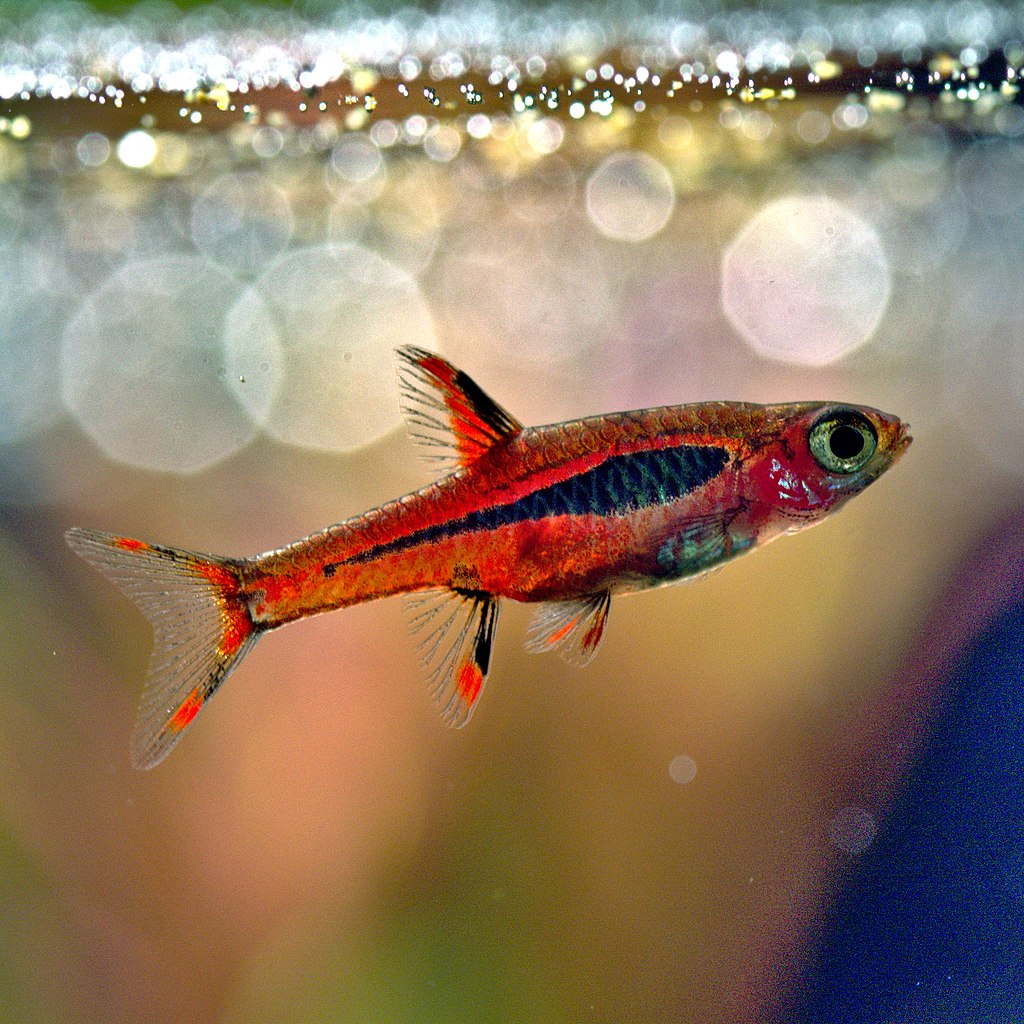
Chili Rasboras are tiny, vibrantly colored fish that pack a punch of personality in a small package. These peaceful, schooling fish occupy the mid-to-upper levels of the aquarium and are known for their lively, playful behavior. Chili Rasboras and Otocinclus make a delightful and entertaining pair, with the Rasboras’ energetic antics providing a lively backdrop to the Otos’ calm and methodical algae-grazing.
Dwarf Corydoras (Corydoras hastatus)
Dwarf Corydoras, like their Pygmy counterparts, are miniature bottom-dwelling catfish that share similar peaceful temperaments and tank requirements with Otocinclus. These social fish are best kept in groups and actively scavenge the substrate for leftover food particles. Dwarf Corydoras and Otocinclus form a charming and efficient cleaning crew, ensuring a well-maintained and pristine aquarium environment.
White Cloud Mountain Minnows (Tanichthys albonubes)
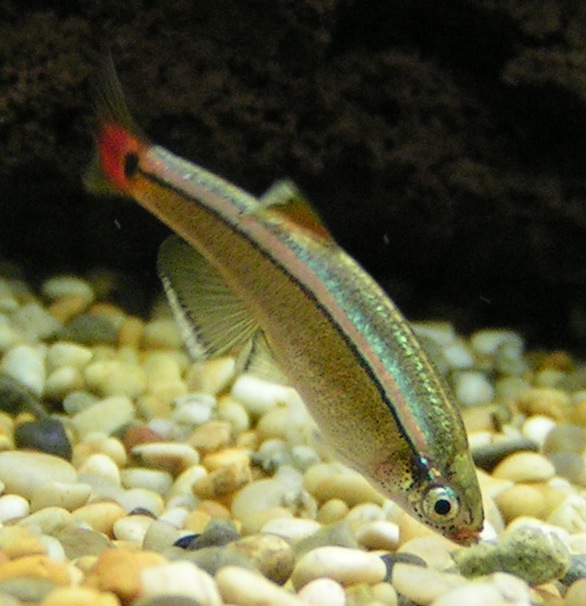
White Cloud Mountain Minnows are hardy, adaptable fish that thrive in a variety of water conditions. These peaceful, schooling fish occupy the mid-to-upper levels of the aquarium and are known for their active swimming behavior. White Cloud Mountain Minnows and Otocinclus create a harmonious and visually appealing combination, with the Minnows’ silvery iridescence complementing the Otos’ subtle earth tones.
Rummy Nose Tetras (Hemigrammus bleheri)
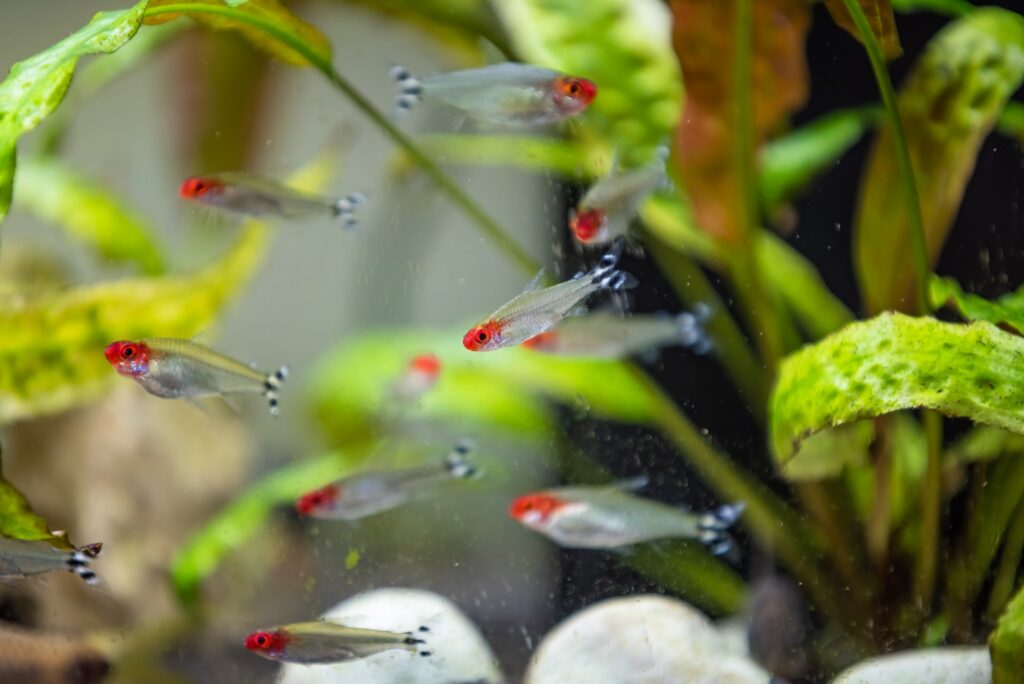
Rummy Nose Tetras are striking, schooling fish known for their distinctive red-and-white coloration. These peaceful fish prefer the mid-level of the aquarium and are most comfortable when kept in groups of six or more. Rummy Nose Tetras and Otocinclus make an eye-catching and tranquil pairing, with the Tetras’ vibrant hues providing a beautiful contrast to the Otos’ muted tones.
Pygmy Hatchetfish (Carnegiella myersi)

Pygmy Hatchetfish are unique, surface-dwelling fish that add a fascinating dimension to the upper levels of the aquarium. These peaceful fish are known for their unusual shape and ability to “fly” above the water’s surface when startled. Pygmy Hatchetfish and Otocinclus create an intriguing and captivating display, with the Hatchetfish’s aerial antics providing an entertaining counterpoint to the Otos’ substrate-grazing habits.
FAQs
How many Otocinclus should I keep together?
Otocinclus are social fish that thrive in groups. It’s recommended to keep at least six Otos together to ensure they feel secure and comfortable in their environment. Keeping a larger group also helps distribute algae-eating duties more efficiently throughout the aquarium.
Can Otocinclus survive in a newly set up tank?
No, Otocinclus require a well-established aquarium with plenty of algae growth to support their dietary needs. It’s best to introduce Otos to a tank that has been running for at least 2-3 months, allowing sufficient time for beneficial bacteria and algae to develop.
Do Otocinclus need special food?
While Otocinclus primarily feed on algae, it’s essential to supplement their diet with high-quality algae wafers and blanched vegetables like spinach, zucchini, and lettuce. This ensures they receive a balanced diet and helps prevent malnourishment, especially in tanks with limited algae growth.
How often should I feed my Otocinclus?
Otocinclus are continuous grazers and require a constant supply of food. In addition to the algae naturally present in the tank, you should offer supplementary foods like algae wafers or blanched vegetables daily. Be sure to remove any uneaten food after a few hours to maintain good water quality.
Can Otocinclus be kept with shrimp?
Yes, Otocinclus are peaceful and shrimp-safe fish. They can coexist harmoniously with various types of shrimp, such as Cherry Shrimp, Amano Shrimp, and Ghost Shrimp. In fact, Otos and shrimp make excellent tank mates, as they both contribute to maintaining a clean aquarium environment.
Do Otocinclus need a heater?
Otocinclus are tropical fish that require stable, warm water temperatures to thrive. A heater is necessary to maintain a consistent temperature range of 72-82°F (22-28°C). Avoid sudden temperature fluctuations, as this can cause stress and weaken their immune system.
How can I tell if my Otocinclus is healthy?
A healthy Otocinclus should have a rounded belly, indicating a well-fed fish. They should be active and constantly grazing on algae throughout the day. Healthy Otos also have clear eyes, intact fins, and smooth skin without any visible signs of disease or abnormalities.
Can Otocinclus jump out of the tank?
While it’s not common, Otocinclus can sometimes jump out of the aquarium if they feel stressed or threatened. To prevent this, ensure your tank has a tight-fitting lid and maintain good water quality. Providing plenty of hiding spots and a peaceful environment can also help reduce stress and minimize the risk of jumping.
How long do Otocinclus live?
With proper care and a well-maintained aquarium, Otocinclus can live for 3 to 5 years. However, their lifespan can be shorter if kept in suboptimal conditions or if they experience stress from incompatible tank mates or poor water quality.
Can Otocinclus be bred in captivity?
Breeding Otocinclus in captivity is possible but challenging. These fish have specific requirements for spawning, including soft, acidic water and the presence of fine-leaved plants for egg deposition. Encouraging Otos to breed in the home aquarium requires careful replication of their natural habitat and spawning conditions.